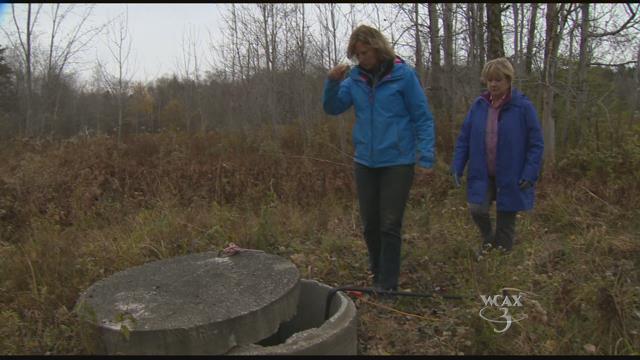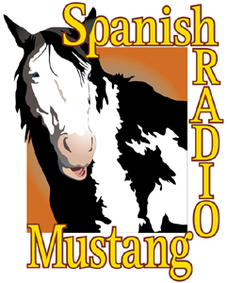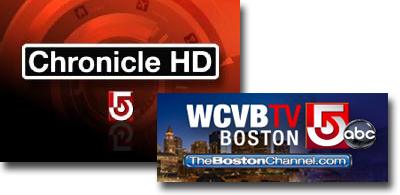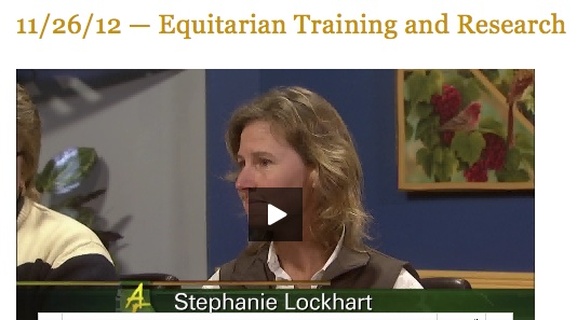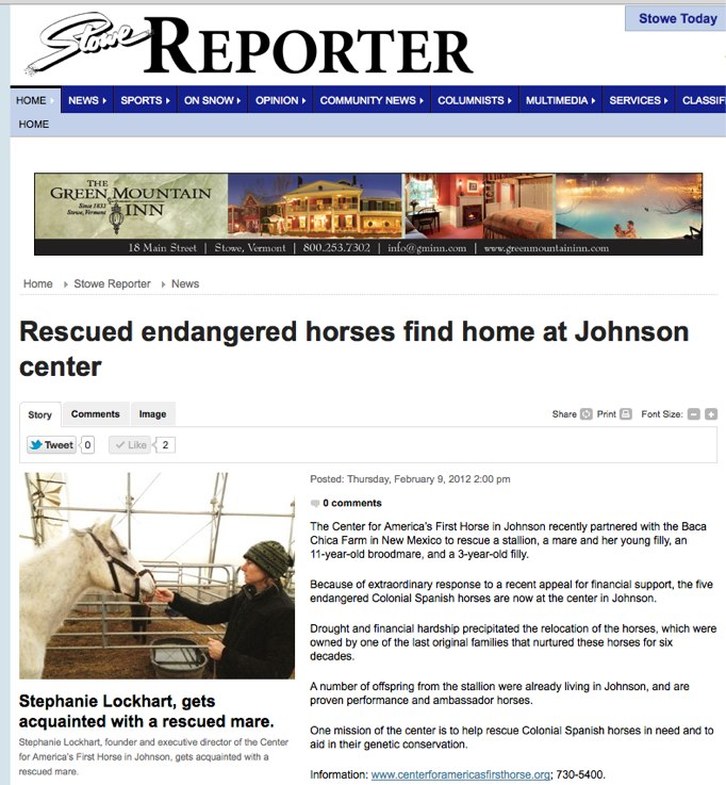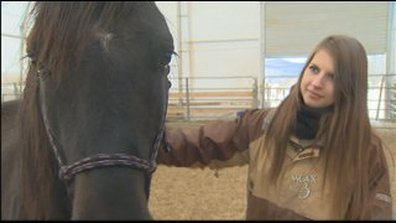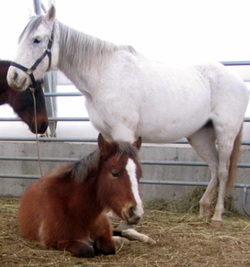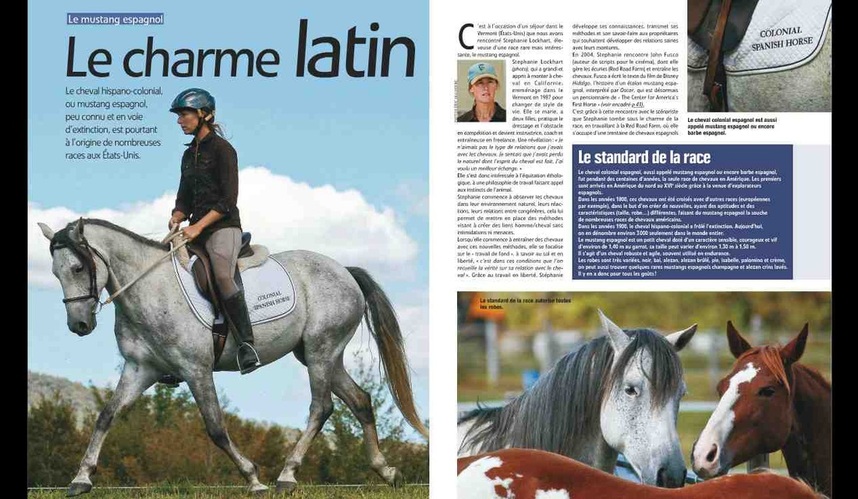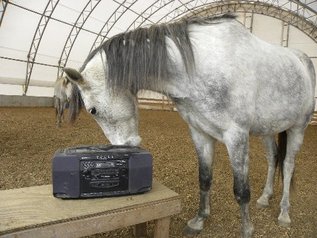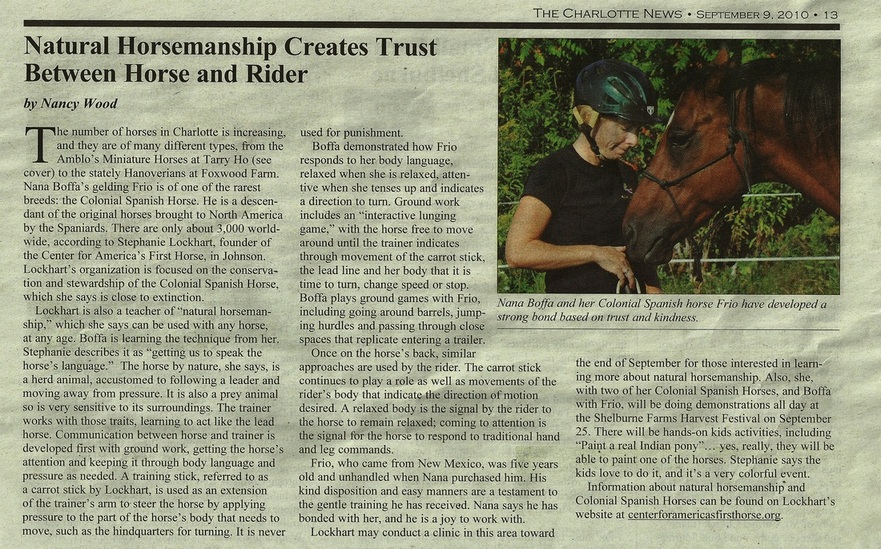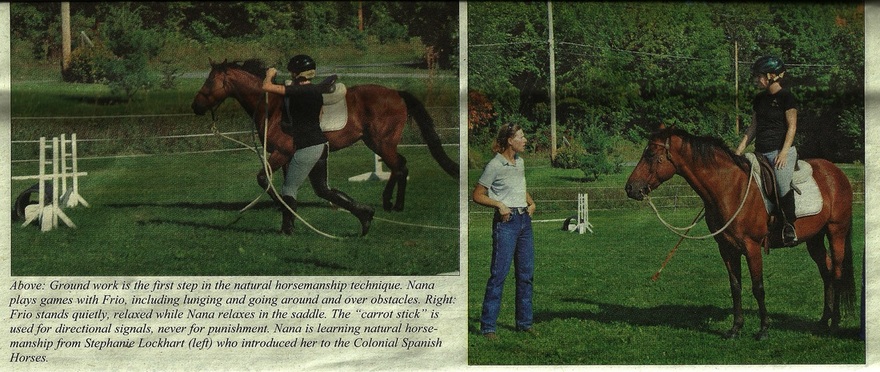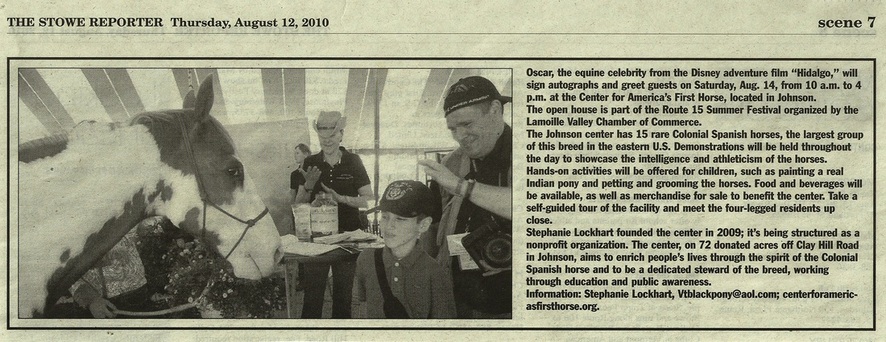News and Media Center
Enjoy some of our press by reading and listening to news about The Center for America's First Horse, Inc., our volunteers and supporters. You can forward our coverage to any potential supporters, share on it your social networks or contact your local media sources about The Center regarding human interest stories. Enjoy learning about what's been said about our unique Spanish Mustangs.
If you would like to subscribe to our E-Newsletter, "The Latest Scoop..." click here.
If you would like to subscribe to our E-Newsletter, "The Latest Scoop..." click here.

Help Horses Get A Needed Reliable Water Source!
October 19, 2015

April 15, 2015
The Healing Powers of Horses
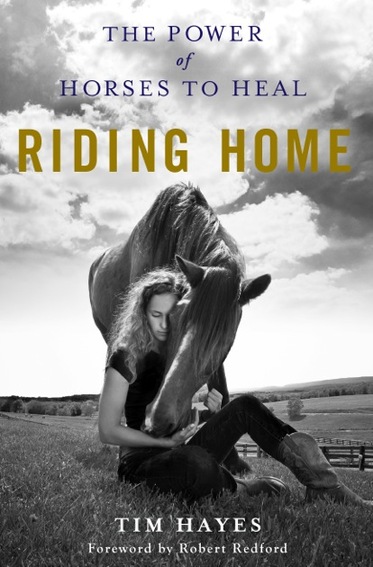
Riding Home:
The Power of Horses To Heal
Tim Hayes; foreword by Robert Redford
St. Martin's Press
What if more children could spend time interacting with horses? Could horses help empower these young folks with both the self worth and a sense of value necessary to overcome some of society’s compulsive obsessions with power, materialism and celebrity?
Stephanie Lockhart believes they can. She has created Natural Horsemanship for Children, one of the first equine programs that utilize the relationship-building skills of natural horsemanship to empower children with more authentic self-worth and compassion, as well as a stronger sense of ethics and morality. Learning the textbook-perfect social skills of the herd dynamics of horses profoundly increases a child’s ability to develop healthier human relationships.
Natural Horsemanship for Children introduces children of all ages to horses and teaches them how to safely interact and create equine relationships. This enables these children to acquire the same love, trust, respect, and compassion that is naturally inherent in the herd dynamics of horses and then utilize these abilities with their parents, their friends, and in all of their other human relationships. Stephanie Lockhart is the founder and program director at
The Center for America’s First Horse, in Johnson, Vermont.
RIDING HOME is available at Smile.Amazon.com.
All pre-order proceeds benefit Natural Horsemanship for Children.
The Power of Horses To Heal
Tim Hayes; foreword by Robert Redford
St. Martin's Press
What if more children could spend time interacting with horses? Could horses help empower these young folks with both the self worth and a sense of value necessary to overcome some of society’s compulsive obsessions with power, materialism and celebrity?
Stephanie Lockhart believes they can. She has created Natural Horsemanship for Children, one of the first equine programs that utilize the relationship-building skills of natural horsemanship to empower children with more authentic self-worth and compassion, as well as a stronger sense of ethics and morality. Learning the textbook-perfect social skills of the herd dynamics of horses profoundly increases a child’s ability to develop healthier human relationships.
Natural Horsemanship for Children introduces children of all ages to horses and teaches them how to safely interact and create equine relationships. This enables these children to acquire the same love, trust, respect, and compassion that is naturally inherent in the herd dynamics of horses and then utilize these abilities with their parents, their friends, and in all of their other human relationships. Stephanie Lockhart is the founder and program director at
The Center for America’s First Horse, in Johnson, Vermont.
RIDING HOME is available at Smile.Amazon.com.
All pre-order proceeds benefit Natural Horsemanship for Children.

June 8, 2014
Opening Worlds with Horses
As I try to imagine a world with no set agendas or expectations, my mind runs rampant.
Could there be a place where looking forward to the future is based on innate instinct rather than an acquired drive to meet the demands and obligations of everyday life?
The short answer to this long question is: yes.
I found this place last weekend at a barn in Johnson on the sprawling green acreage of The Center for America’s First Horse.
In fact, such a place exists anywhere there are horses. The horse is a hyper-vigilant prey animal that constantly acts on instinct — the opposite of humans’ calculated, predatory predilections.
As someone who spent countless hours with horses as a child at my grandparents’ farm, I forgot such a simple place could exist.
This forgotten world was re-imagined over the weekend during a clinic on natural horsemanship conducted by the center’s founder Stephanie Lockhart and her partner Tim Hayes.
Lockhart and Hayes make their livings training both humans and horses about natural horsemanship — what is natural for the horse versus what is natural for the human.
Seeing the world through a horse’s wide-set eyes for just a few hours creates a natural understanding of the animal’s psychology and behaviors.
After patience and practice on behalf of both humans and horses, a non-verbal form of communication emerged between the riders who signed up for the clinic and their four-legged counterparts — and it was truly magical.
Horses are fascinating animals that have survived on earth much longer than humans.
They’ve solidified an important place in history as a food source, a means of transportation, a provider of physical labor and an instrument of war.
Over the years, an ancient, symbiotic relationship between man and horse thrived.
And, more recently, this unique animal-human bond has started gaining traction as a form of therapy for people suffering from mental and physical afflictions. Like the men and women of the armed forces, who return home from war grappling with post-traumatic stress disorder. Or the young child growing up with autism unable to clearly articulate thoughts.
People young and old with such issues are entering into the horse’s world — a special place built on love, understanding and acceptance with no hidden agendas or expectations.
In Hayes’ clinic, four participants of varying horsemanship skill levels worked alongside horses of varying ages and attention spans.
Two participants brought their own horses, while the others worked alongside Spanish mustangs who live at the center.
But everyone had a common goal in mind: To learn more about themselves through the powerful personality of the horse.
“It’s about learning about us, and the horse is our mirror,” Hayes repeated throughout the clinic. “If the horse is misbehaving, then I need to change something I’m doing.”
The same can be said for our personal and social relationships.
Hayes and Lockhart teach that interacting with horses in a way that includes physical, mental and emotional understanding has the power to create a partnership based on three key qualities: mutual love, trust and respect.
Whether we own a horse or just admire them from afar, maybe we could all benefit from being on their clock, in a world without agendas but rich with life.
The Center for America’s First Horse will hold an open house on Saturday, June 7, from 12 to 3 p.m. There will be a free day of demos, horses and activities. The center is located on Route 15 in Johnson.
To learn more about Tim Hayes, visit hayesisforhorses.com. For more information on The Center for America’s First Horse, call 730-5400 or visit centerforamericasfirsthorse.org.
Miranda Orso of Stowe is a reporter for the Stowe Reporter and Waterbury Record.
Could there be a place where looking forward to the future is based on innate instinct rather than an acquired drive to meet the demands and obligations of everyday life?
The short answer to this long question is: yes.
I found this place last weekend at a barn in Johnson on the sprawling green acreage of The Center for America’s First Horse.
In fact, such a place exists anywhere there are horses. The horse is a hyper-vigilant prey animal that constantly acts on instinct — the opposite of humans’ calculated, predatory predilections.
As someone who spent countless hours with horses as a child at my grandparents’ farm, I forgot such a simple place could exist.
This forgotten world was re-imagined over the weekend during a clinic on natural horsemanship conducted by the center’s founder Stephanie Lockhart and her partner Tim Hayes.
Lockhart and Hayes make their livings training both humans and horses about natural horsemanship — what is natural for the horse versus what is natural for the human.
Seeing the world through a horse’s wide-set eyes for just a few hours creates a natural understanding of the animal’s psychology and behaviors.
After patience and practice on behalf of both humans and horses, a non-verbal form of communication emerged between the riders who signed up for the clinic and their four-legged counterparts — and it was truly magical.
Horses are fascinating animals that have survived on earth much longer than humans.
They’ve solidified an important place in history as a food source, a means of transportation, a provider of physical labor and an instrument of war.
Over the years, an ancient, symbiotic relationship between man and horse thrived.
And, more recently, this unique animal-human bond has started gaining traction as a form of therapy for people suffering from mental and physical afflictions. Like the men and women of the armed forces, who return home from war grappling with post-traumatic stress disorder. Or the young child growing up with autism unable to clearly articulate thoughts.
People young and old with such issues are entering into the horse’s world — a special place built on love, understanding and acceptance with no hidden agendas or expectations.
In Hayes’ clinic, four participants of varying horsemanship skill levels worked alongside horses of varying ages and attention spans.
Two participants brought their own horses, while the others worked alongside Spanish mustangs who live at the center.
But everyone had a common goal in mind: To learn more about themselves through the powerful personality of the horse.
“It’s about learning about us, and the horse is our mirror,” Hayes repeated throughout the clinic. “If the horse is misbehaving, then I need to change something I’m doing.”
The same can be said for our personal and social relationships.
Hayes and Lockhart teach that interacting with horses in a way that includes physical, mental and emotional understanding has the power to create a partnership based on three key qualities: mutual love, trust and respect.
Whether we own a horse or just admire them from afar, maybe we could all benefit from being on their clock, in a world without agendas but rich with life.
The Center for America’s First Horse will hold an open house on Saturday, June 7, from 12 to 3 p.m. There will be a free day of demos, horses and activities. The center is located on Route 15 in Johnson.
To learn more about Tim Hayes, visit hayesisforhorses.com. For more information on The Center for America’s First Horse, call 730-5400 or visit centerforamericasfirsthorse.org.
Miranda Orso of Stowe is a reporter for the Stowe Reporter and Waterbury Record.
April 7, 2014 Interview with Stephanie Lockhart
Dr. Phillip Sponenberg's Recent Endorsement Letter
October 2, 2013 Interview with Stephanie Lockhart & Janis Cooper
VT Nonprofit's Mission to Save Rare Horse Breed

July 29, 2013
Two of a Kind: Dressage and Natural Horsemanship Trainers Walter Zettl, Karen Rohlf, Stephanie Lockhart and Greg Eliel Discuss How Their Principles Can Go Hand-in-Hand.
Pages 42 - 44
Horseplay leads to enhanced business productivity
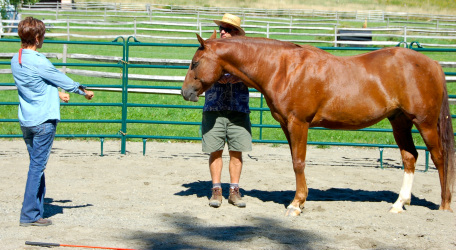
Partnering with certified Equine Facilitated Learning Coach, Janis Cooper, the Center for America’s First Horse is now offering Equine Facilitated Learning and Coaching (EFLC) Workshops, which focus on building leadership skills and strengthening corporate teams.
Today's businesses are looking for new and innovative ways to enhance employee participation and leadership. EFLC workshops can be customized for individual groups in either 1 or 2-day formats. No riding experience is necessary; all learning is done with the horses from the ground in a safe environment, and there is an indoor arena at the Center if weather doesn’t permit outdoor activity.
Cooper comments, “As a corporate leader for the past 20 years, I recognize the need to accelerate learning in areas of team building, leadership and relationship development. We’re excited to connect people and horses in a dynamic process where individuals learn to identify and shift their limiting behavior patterns. Workshop participants will become more successful as influential leaders in team building, conflict resolution, and interpersonal communication - all skills crucial in today’s marketplace.“
Teaming with Cooper on these workshops is Center founder and Natural Horsemanship educator, Stephanie Lockhart, who adds, "Horses have a powerful way of teaching us what our strengths and weaknesses are. They’re great at helping people develop skills necessary to succeed in personal and business relations. EFLC is the gateway to learning more about ourselves."
Workshops are now being booked for the 2013 spring and fall seasons. Businesses may contact Janis Cooper at 802.496.2730/ info@eqnimity.com for booking and information,
The Center for America’s First Horse would be happy to assist those coming from a distance in securing affordable accommodations in the greater Johnson/Stowe area.
About the Center for America’s First Horse
The Center for America’s First Horse, Incorporated (non-profit, 501(c )3), founded by Stephanie Lockhart in Johnson, Vermont, is home to the most diverse herd of Colonial Spanish horses in the eastern United States. Their mission is to enrich lives through the spirit of the Colonial Spanish horse. The Center offers programs focusing on education and public awareness, natural horsemanship, community outreach, work-study and promotion and preservation of the Colonial Spanish horse.
www.centerforamericasfirsthorse.org
More Information
About Equine Facilitated Learning Leadership and Team Development:
http://www.eqnimity.com/working-together/leadership-team-development/
About Janis Cooper:
http://www.eqnimity.com/about/
About Stephanie Lockhart:
http://www.centerforamericasfirsthorse.org/board-of-directors.html
About The Center for America’s First Horse:
http://www.centerforamericasfirsthorse.org
Today's businesses are looking for new and innovative ways to enhance employee participation and leadership. EFLC workshops can be customized for individual groups in either 1 or 2-day formats. No riding experience is necessary; all learning is done with the horses from the ground in a safe environment, and there is an indoor arena at the Center if weather doesn’t permit outdoor activity.
Cooper comments, “As a corporate leader for the past 20 years, I recognize the need to accelerate learning in areas of team building, leadership and relationship development. We’re excited to connect people and horses in a dynamic process where individuals learn to identify and shift their limiting behavior patterns. Workshop participants will become more successful as influential leaders in team building, conflict resolution, and interpersonal communication - all skills crucial in today’s marketplace.“
Teaming with Cooper on these workshops is Center founder and Natural Horsemanship educator, Stephanie Lockhart, who adds, "Horses have a powerful way of teaching us what our strengths and weaknesses are. They’re great at helping people develop skills necessary to succeed in personal and business relations. EFLC is the gateway to learning more about ourselves."
Workshops are now being booked for the 2013 spring and fall seasons. Businesses may contact Janis Cooper at 802.496.2730/ info@eqnimity.com for booking and information,
The Center for America’s First Horse would be happy to assist those coming from a distance in securing affordable accommodations in the greater Johnson/Stowe area.
About the Center for America’s First Horse
The Center for America’s First Horse, Incorporated (non-profit, 501(c )3), founded by Stephanie Lockhart in Johnson, Vermont, is home to the most diverse herd of Colonial Spanish horses in the eastern United States. Their mission is to enrich lives through the spirit of the Colonial Spanish horse. The Center offers programs focusing on education and public awareness, natural horsemanship, community outreach, work-study and promotion and preservation of the Colonial Spanish horse.
www.centerforamericasfirsthorse.org
More Information
About Equine Facilitated Learning Leadership and Team Development:
http://www.eqnimity.com/working-together/leadership-team-development/
About Janis Cooper:
http://www.eqnimity.com/about/
About Stephanie Lockhart:
http://www.centerforamericasfirsthorse.org/board-of-directors.html
About The Center for America’s First Horse:
http://www.centerforamericasfirsthorse.org
Main Streets and Back Roads of Stowe, Vermont, HD Television
University of Vermont's Across The Fence on WCAX TV
NY Horse Directory magazine
Rare Rescued Horses Find a Home in Johnson

Click for the video interview
A handful or Vermonters spent their Sunday nursing a rare breed of horse back to health.
These horses in Johnson, Vermont are a piece of history. More than 500 years ago their forefathers were the first to set hooves on American soil. Now, there are only about 3-thousand left in the world.
"I fell in love with the breed and it's just evolved into founding this nonprofit organization," said Stephanie Lockhart.
"I just fell in love with them and once I learned their story I just realized how important is to save the breed," said Brenda Hedges.
Lockhart and Hedges are two of about twenty people who run The Center for America's First Horse. The all-volunteer staff are nursing five of Colonial Spanish horses back to health.
"We really felt that it was something we have to do for these horses," Lockhart said. "They actually are looking a lot better than I anticipated."
The horses come from New Mexico where their former owner could no longer properly take care of them. Trainers say each horse needs to gain at least 100 pounds.
"They get hay, as much as they can eat around the clock to keep warm and they're doing really well," Lockhart said.
The non-profit secured donations from around the globe to bring them to Vermont. But caring for the 21 horses is expensive. "This year we're looking at a budget about 106-thousand and that just barely covers the cost of feeding the horses and keeping the operation running," Hedges said.
The volunteers say they're making hay through fundraisers and by drawing tourists from locations as far off as France, Switzerland, and even Mongolia.
All in an effort to save America's original horse.
These horses in Johnson, Vermont are a piece of history. More than 500 years ago their forefathers were the first to set hooves on American soil. Now, there are only about 3-thousand left in the world.
"I fell in love with the breed and it's just evolved into founding this nonprofit organization," said Stephanie Lockhart.
"I just fell in love with them and once I learned their story I just realized how important is to save the breed," said Brenda Hedges.
Lockhart and Hedges are two of about twenty people who run The Center for America's First Horse. The all-volunteer staff are nursing five of Colonial Spanish horses back to health.
"We really felt that it was something we have to do for these horses," Lockhart said. "They actually are looking a lot better than I anticipated."
The horses come from New Mexico where their former owner could no longer properly take care of them. Trainers say each horse needs to gain at least 100 pounds.
"They get hay, as much as they can eat around the clock to keep warm and they're doing really well," Lockhart said.
The non-profit secured donations from around the globe to bring them to Vermont. But caring for the 21 horses is expensive. "This year we're looking at a budget about 106-thousand and that just barely covers the cost of feeding the horses and keeping the operation running," Hedges said.
The volunteers say they're making hay through fundraisers and by drawing tourists from locations as far off as France, Switzerland, and even Mongolia.
All in an effort to save America's original horse.
_Johnson Center Rescues Rare Historic Horse Breed
Posted by Kathryn Flagg on January 31, 2012 at 03:12 PM
A horse is a horse, of course, of course — unless that horse happens to be a rare breed called the Colonial Spanish. In that case, says horse enthusiast Stephanie Lockhart, don’t mistake the hardy little steed for just any old pony.
These were the mounts first introduced to the then-New World by Spanish conquistadors in the 16th century. The horses were later adopted by some American Indian tribes, and raced across the West carrying Pony Express mail carriers.
“These were the first horses in America,” says Lockhart of the horses, also called Spanish mustangs. “They’re like old souls. You look into their eyes, and you can just see the history involved.”
For the five newest horses at Lockhart’s nonprofit, The Center for America’s First Horse in Johnson, more recent history was a hard-knocks affair: Until earlier this month, the horses were living in New Mexico, where record-breaking drought conditions meant hay, grazing and water were expensive and hard to come by. The horses were thin, and their aging owners — who had been raising the Colonial Spanish for 60 years to keep the historic breed alive — knew they couldn’t keep them any longer.
That’s where Lockhart entered the picture. She’s been visiting the ranch for the last eight years, slowly acquiring her own collection of Colonial Spanish horses. She got a phone call in November asking if she could take on a few more horses. Her response? “I just kept saying, ‘I don’t know how I could make this happen.’”
Now, two months and a massive fundraising effort later, happened it has. Last week the Center for America’s First Horse welcomed a stallion, a mare and her young filly, an 11-year-old broodmare, and a 3-year-old filly to the herd, bringing the total number of Colonial Spanish horses tucked away in Johnson to 21.
Lockhart says the relocation was only possible because of a tremendous outpouring of support from horse lovers across the country. Transport fees for the five horses clocked in at around $4500 dollars. To cobble together the funding, Lockhart’s center started a “cards for colts” campaign in December, asking supporters to send along a dollar tucked into a Christmas card. For three weeks the cards poured in, each with a donation big or small and a note of encouragement.
“These were people that I didn’t know,” says Lockhart, who likely heard about the relocation effort through the center’s outreach on social-media sites. “There’s some really great things about humanity, when people can send something to people they don’t know. It just felt like it brought out the best in people.”
In three weeks’ time, the center raised exactly the amount of money they needed — within $50 — to ship the horses from New Mexico to Vermont. Lockhart had seen photographs that indicated the horses were quite thin, and she worried about the stress that travel might have on the animals.
“Even for a healthy horse that’s in perfect shape, it’s a very stressful situation for them,” Lockhart says. In response, a New Mexico woman donated more than a month’s worth of food to help the horses prepare for the journey.
Lockhart stumbled into her calling to preserve the Colonial Spanish horse. Though she’s long been a “horse person,” eight years ago she owned just one horse. That’s when her daughter, Eliza, decided to donate the money she received for her seventh birthday to a conservancy protecting heritage horse breeds. In return, she received a thick stack of raffle tickets for an upcoming drawing to give away a Colonial Spanish colt.
Eliza didn’t win the raffle — but when the winning teenager heard about Eliza’s generosity, she decided to give the colt to the seven-year-old instead.
Eight years later, after after establishing a fast friendship with the New Mexico family who raised the animals, Lockhart now cares for 21 horses. After a stint in New Mexico in 2008 to start a horse conservancy, she returned to Vermont determined to find a way to protect the Colonial Spanish, and set up the Center for America’s First Horse. (The center welcomes visitors curious about the horses, and is also home to Oscar, one of horses who played the title role in the 2004 movie Hidalgo.)
“I’m trying to save something from the past,” says Lockhart, who likens the horses to the American buffalo. Once number in the millions, there are now fewer than 3000 Spanish Colonial horses alive today. Lockhart says she’s trying to demonstrate the horses’ athleticism, endurance, perseverance and spirit.
“They’re not going to survive on their history, I’m certain of that,” says Lockhart. “But they can survive when people start recognizing what these horses can do.”
A horse is a horse, of course, of course — unless that horse happens to be a rare breed called the Colonial Spanish. In that case, says horse enthusiast Stephanie Lockhart, don’t mistake the hardy little steed for just any old pony.
These were the mounts first introduced to the then-New World by Spanish conquistadors in the 16th century. The horses were later adopted by some American Indian tribes, and raced across the West carrying Pony Express mail carriers.
“These were the first horses in America,” says Lockhart of the horses, also called Spanish mustangs. “They’re like old souls. You look into their eyes, and you can just see the history involved.”
For the five newest horses at Lockhart’s nonprofit, The Center for America’s First Horse in Johnson, more recent history was a hard-knocks affair: Until earlier this month, the horses were living in New Mexico, where record-breaking drought conditions meant hay, grazing and water were expensive and hard to come by. The horses were thin, and their aging owners — who had been raising the Colonial Spanish for 60 years to keep the historic breed alive — knew they couldn’t keep them any longer.
That’s where Lockhart entered the picture. She’s been visiting the ranch for the last eight years, slowly acquiring her own collection of Colonial Spanish horses. She got a phone call in November asking if she could take on a few more horses. Her response? “I just kept saying, ‘I don’t know how I could make this happen.’”
Now, two months and a massive fundraising effort later, happened it has. Last week the Center for America’s First Horse welcomed a stallion, a mare and her young filly, an 11-year-old broodmare, and a 3-year-old filly to the herd, bringing the total number of Colonial Spanish horses tucked away in Johnson to 21.
Lockhart says the relocation was only possible because of a tremendous outpouring of support from horse lovers across the country. Transport fees for the five horses clocked in at around $4500 dollars. To cobble together the funding, Lockhart’s center started a “cards for colts” campaign in December, asking supporters to send along a dollar tucked into a Christmas card. For three weeks the cards poured in, each with a donation big or small and a note of encouragement.
“These were people that I didn’t know,” says Lockhart, who likely heard about the relocation effort through the center’s outreach on social-media sites. “There’s some really great things about humanity, when people can send something to people they don’t know. It just felt like it brought out the best in people.”
In three weeks’ time, the center raised exactly the amount of money they needed — within $50 — to ship the horses from New Mexico to Vermont. Lockhart had seen photographs that indicated the horses were quite thin, and she worried about the stress that travel might have on the animals.
“Even for a healthy horse that’s in perfect shape, it’s a very stressful situation for them,” Lockhart says. In response, a New Mexico woman donated more than a month’s worth of food to help the horses prepare for the journey.
Lockhart stumbled into her calling to preserve the Colonial Spanish horse. Though she’s long been a “horse person,” eight years ago she owned just one horse. That’s when her daughter, Eliza, decided to donate the money she received for her seventh birthday to a conservancy protecting heritage horse breeds. In return, she received a thick stack of raffle tickets for an upcoming drawing to give away a Colonial Spanish colt.
Eliza didn’t win the raffle — but when the winning teenager heard about Eliza’s generosity, she decided to give the colt to the seven-year-old instead.
Eight years later, after after establishing a fast friendship with the New Mexico family who raised the animals, Lockhart now cares for 21 horses. After a stint in New Mexico in 2008 to start a horse conservancy, she returned to Vermont determined to find a way to protect the Colonial Spanish, and set up the Center for America’s First Horse. (The center welcomes visitors curious about the horses, and is also home to Oscar, one of horses who played the title role in the 2004 movie Hidalgo.)
“I’m trying to save something from the past,” says Lockhart, who likens the horses to the American buffalo. Once number in the millions, there are now fewer than 3000 Spanish Colonial horses alive today. Lockhart says she’s trying to demonstrate the horses’ athleticism, endurance, perseverance and spirit.
“They’re not going to survive on their history, I’m certain of that,” says Lockhart. “But they can survive when people start recognizing what these horses can do.”
Above Article Translated from French to English
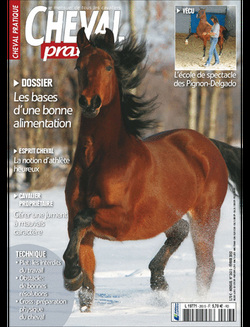
Cheval Pratique Magazine, February 2012
_The Latin charm.
The Spanish colonial horse or Spanish mustang, not well known and on its way to extinction, it contributed to many other Breeds in the united states.
It was during a trip to Vermont (USA) that we met Stephanie Lockhart, breeder of a rare and interesting breed: the Spanish Mustang.
Stephanie Lockhart (photo) grew up and learned to ride in California, she moved to Vermont in 1987 for a change of lifestyle. She got married and had 2 daughters, rode dressage and show jumped in competition. She is also a freelance riding instructor, coach and trainer. A revelation "I didn't like the relationship I had with horses. I felt I had lost touch with the natural way and wanted a better relationship with them. "
She then started natural horsemanship, a way of working with the natural instincts of the horse. Stephanie started observing horses in their natural environment , their reactions and relations with each other. This allowed her to create human/horse bonds without using force or dominating them.
Once she started using these training methods, she focused on the basics - ground work and working in liberty. Thanks to these training methods Stephanie gained more knowledge and uses her methods to help owners with their own horses.In 2004, Stephanie met John Fusco (script writer for films) for whom she runs the yard (Red Road Farm) and trains horses. Fusco wrote the script for the Disney film Hildalgo, the story of a Spanish Mustang stallion played by Oscar who now lives at the Center For America's First Horse.
It was thanks to Fusco that Stephanie fell for the charm of the Spanish Mustang, working at the Red Road Farm where she cares for and trains Spanish Colonial horses. Adelantado was the first horse of this breed that Stephanie owned, he still lives with her at the Center. The bond between Stephanie and Adelantado came about in a strange way. Eliza, one of her daughters gave all the money she received for her birthday to the Horse Of Americas Registry, in return the association entered her in a raffle where she won first prize: a black colt, Adelantado. His breeders recognized Stephanie's talents and gave her 4 of their horses to train. Two years on she has around 30 horses to train.
In 2008 Stephanie spent 10 months in New Mexico with 6 of her horses at the Sand Hill Development Center, where she practised equine psychotherapy. She worked with children of all different ages with emotional attachment problems. As time progressed she noticed the horses had a positive effect on the children. She discovered these horses were particularly good at this so decided to adapt her natural horsemanship methods to work with children. When Stephanie returned to Vermont she started working with students at Laraway school in Johnson and found a real joy doing this. She decided to offer courses with the horses to those who wanted and needed it. To do this she needed a structure where she could accommodate horses, interested students, hold demos and courses. She created a non profit association: The Center for America's First Horse.
This Center was created by Stephanie Lockhart in 2010 and serves to preserve and educate the public about the breed. It was thanks to Gilbert Lopes and Susan Aldrich, a couple from Johnson (Vermont) that this project was able to happen. In April 2010 they decided go generously donated a large area on which volunteers helped build the Center so that Stephanie could persue her project. These volunteers are 6 women who are passionate about the horses: Brenda Hedges, Jo Sabel Courtney, Deirdre O'Malley, Elsie M Brennan, Deanna Stoppler, Mary Anne M Machis. They help drive the project forward. The association receives school groups, families and anyone who wants to participate In a demo, visit the Center, meet the horses and Learn about the breed. Visitors can leave with an autograph from the centers mascot Oscar ( the main horse from the film Hidalgo). The association survives solely on donations.
Breed standard
The Spanish Colonial horse also called Spanish Mustang and Spanish Barb was for hundreds of years the only horse breed in America. The first ones arrived in North America in the 16th century with the Spanish explorers. In the 1800's these horses were cross bred with other European breeds to create new ones making the Spanish mustang the founder to many American breeds. In the 1900's the SM was on the brink of extinction and nowadays there are only around 3000 in the world. The Spanish Mustang is a small horse with a sensible yet courageous character. They stand around 14hh but range from 13hh to 15hh. They are strong, robust but remain agile often used in endurance. Their coat comes in many colors: black, bay, chestnut, dun, cremello..... There are also rarer colours such as champagne. There is a color for every different taste!
The Spanish colonial horse or Spanish mustang, not well known and on its way to extinction, it contributed to many other Breeds in the united states.
It was during a trip to Vermont (USA) that we met Stephanie Lockhart, breeder of a rare and interesting breed: the Spanish Mustang.
Stephanie Lockhart (photo) grew up and learned to ride in California, she moved to Vermont in 1987 for a change of lifestyle. She got married and had 2 daughters, rode dressage and show jumped in competition. She is also a freelance riding instructor, coach and trainer. A revelation "I didn't like the relationship I had with horses. I felt I had lost touch with the natural way and wanted a better relationship with them. "
She then started natural horsemanship, a way of working with the natural instincts of the horse. Stephanie started observing horses in their natural environment , their reactions and relations with each other. This allowed her to create human/horse bonds without using force or dominating them.
Once she started using these training methods, she focused on the basics - ground work and working in liberty. Thanks to these training methods Stephanie gained more knowledge and uses her methods to help owners with their own horses.In 2004, Stephanie met John Fusco (script writer for films) for whom she runs the yard (Red Road Farm) and trains horses. Fusco wrote the script for the Disney film Hildalgo, the story of a Spanish Mustang stallion played by Oscar who now lives at the Center For America's First Horse.
It was thanks to Fusco that Stephanie fell for the charm of the Spanish Mustang, working at the Red Road Farm where she cares for and trains Spanish Colonial horses. Adelantado was the first horse of this breed that Stephanie owned, he still lives with her at the Center. The bond between Stephanie and Adelantado came about in a strange way. Eliza, one of her daughters gave all the money she received for her birthday to the Horse Of Americas Registry, in return the association entered her in a raffle where she won first prize: a black colt, Adelantado. His breeders recognized Stephanie's talents and gave her 4 of their horses to train. Two years on she has around 30 horses to train.
In 2008 Stephanie spent 10 months in New Mexico with 6 of her horses at the Sand Hill Development Center, where she practised equine psychotherapy. She worked with children of all different ages with emotional attachment problems. As time progressed she noticed the horses had a positive effect on the children. She discovered these horses were particularly good at this so decided to adapt her natural horsemanship methods to work with children. When Stephanie returned to Vermont she started working with students at Laraway school in Johnson and found a real joy doing this. She decided to offer courses with the horses to those who wanted and needed it. To do this she needed a structure where she could accommodate horses, interested students, hold demos and courses. She created a non profit association: The Center for America's First Horse.
This Center was created by Stephanie Lockhart in 2010 and serves to preserve and educate the public about the breed. It was thanks to Gilbert Lopes and Susan Aldrich, a couple from Johnson (Vermont) that this project was able to happen. In April 2010 they decided go generously donated a large area on which volunteers helped build the Center so that Stephanie could persue her project. These volunteers are 6 women who are passionate about the horses: Brenda Hedges, Jo Sabel Courtney, Deirdre O'Malley, Elsie M Brennan, Deanna Stoppler, Mary Anne M Machis. They help drive the project forward. The association receives school groups, families and anyone who wants to participate In a demo, visit the Center, meet the horses and Learn about the breed. Visitors can leave with an autograph from the centers mascot Oscar ( the main horse from the film Hidalgo). The association survives solely on donations.
Breed standard
The Spanish Colonial horse also called Spanish Mustang and Spanish Barb was for hundreds of years the only horse breed in America. The first ones arrived in North America in the 16th century with the Spanish explorers. In the 1800's these horses were cross bred with other European breeds to create new ones making the Spanish mustang the founder to many American breeds. In the 1900's the SM was on the brink of extinction and nowadays there are only around 3000 in the world. The Spanish Mustang is a small horse with a sensible yet courageous character. They stand around 14hh but range from 13hh to 15hh. They are strong, robust but remain agile often used in endurance. Their coat comes in many colors: black, bay, chestnut, dun, cremello..... There are also rarer colours such as champagne. There is a color for every different taste!
Stephanie Lockhart's "Horses in the Morning" Radio Interview
Stowe Guide Magazine, 2011 Summer/Fall Issuse
Stephanie Lockhart's Interview on "Horses in the Morning" Radio
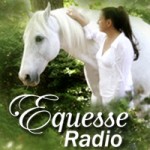
Click to download Podcast
Mustang Advocates Stephanie Lockhart and Hidalgo’s Oscar. In this episode, Cynthia and Leah talk with Spanish mustang advocates Stephanie Lockhart with Oscar, one of four horses to play the starring role in Hidalgo. Like Frank T. Hopkins and his equine partner Hidalgo in Disney’s epic adventure of the same name, sometimes . . . despite doubts or distance or despair – you’ve simply gotta accept the challenge before you, point your nose in the right direction and as Nike aptly says…’Just Do It!’
Equesse Radio Podcast #5
Equesse Radio Podcast #5
*We are a Vermont non-profit corporation and federal 501(c)(3) non-profit organization.
